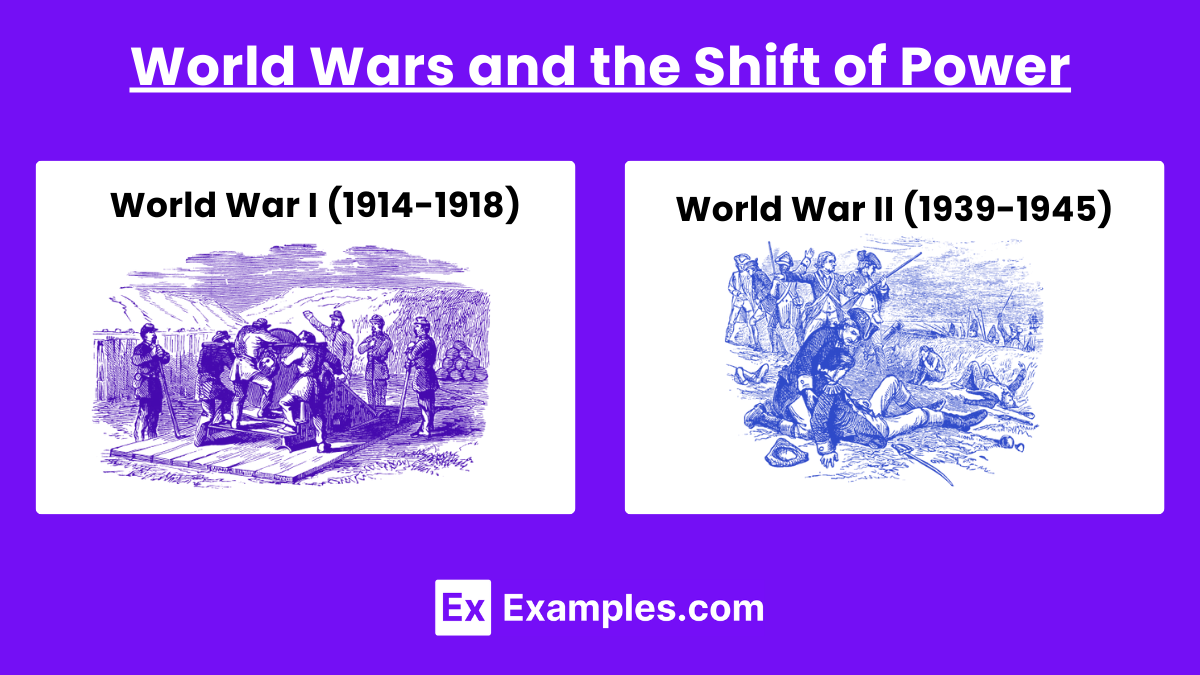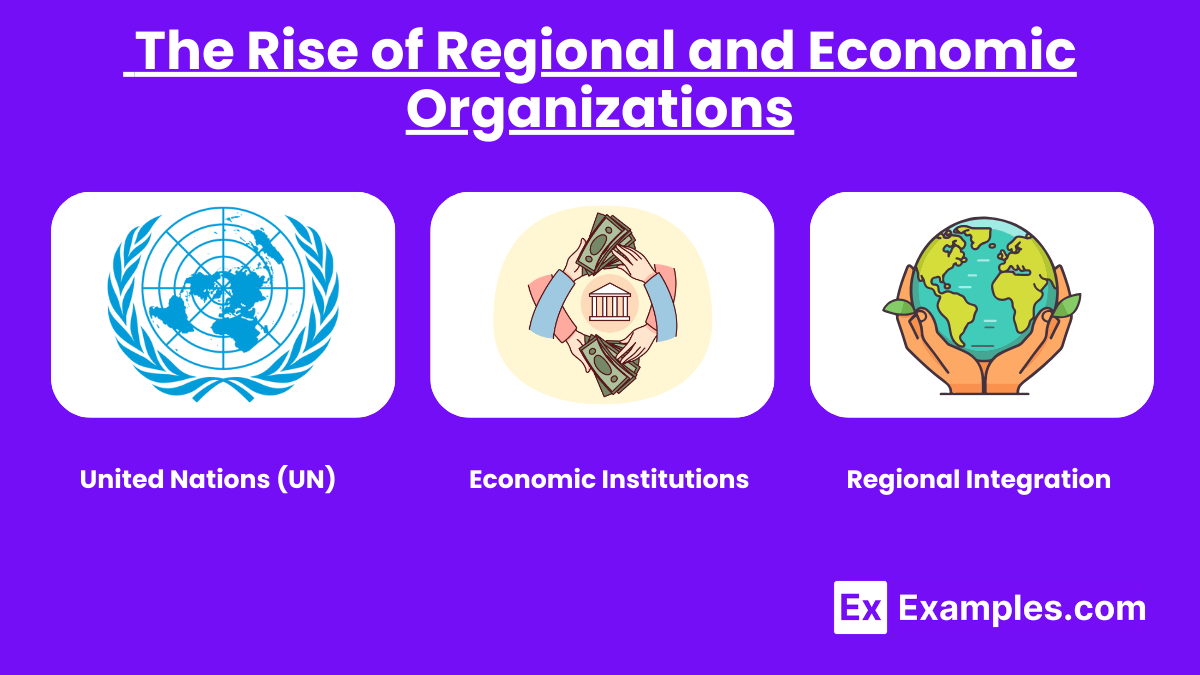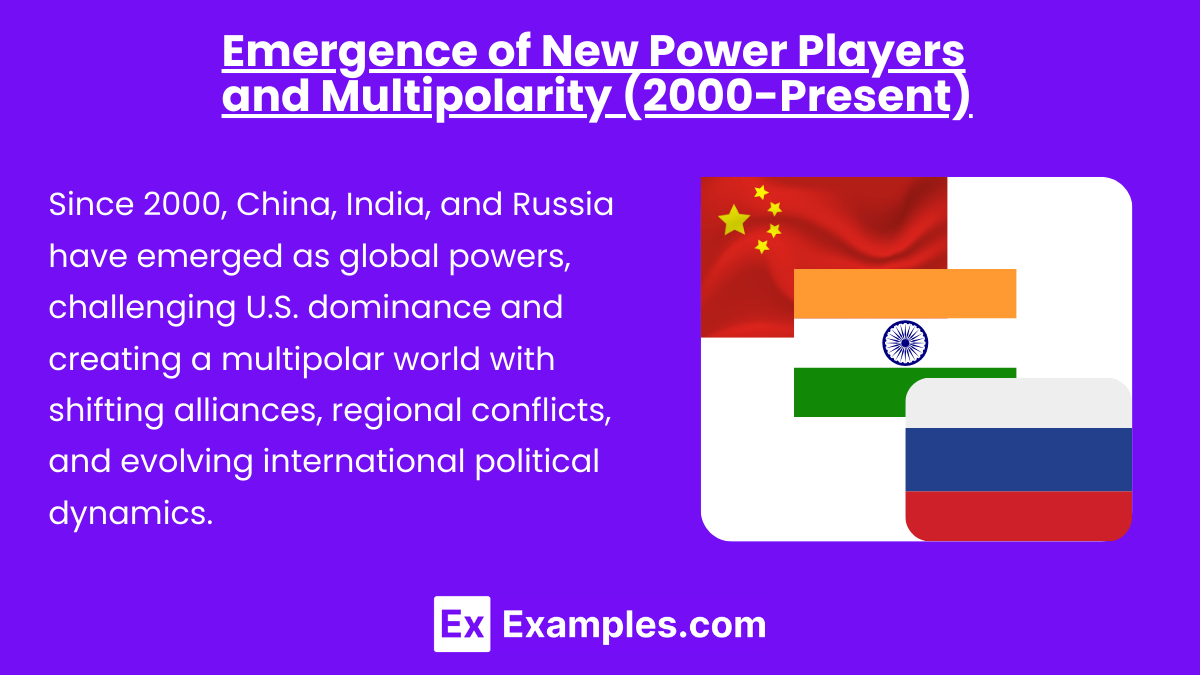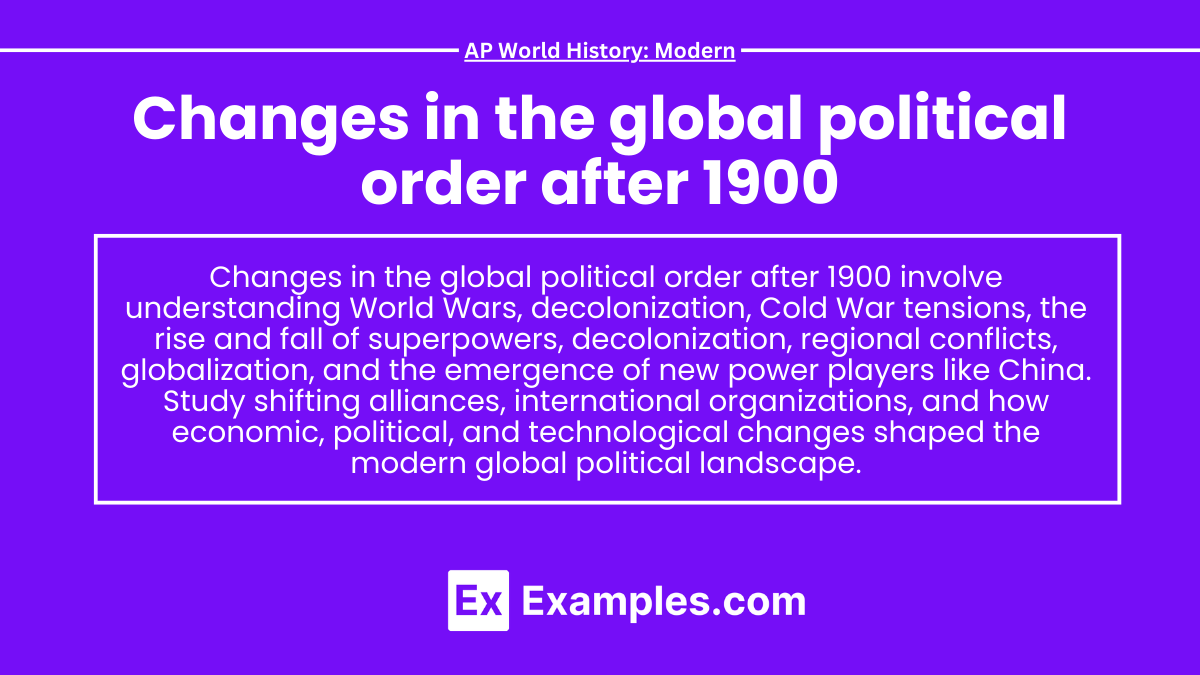Changes in the global political order after 1900 were driven by two World Wars, the rise and fall of empires, decolonization, the Cold War, and the emergence of new superpowers. This period saw a transition from colonial dominance to the establishment of independent nation-states, the end of the bipolar world order, and the shift toward a multipolar world shaped by economic globalization.
Learning Objective
In studying changes in the global political order after 1900 for AP World History: Modern, understand the causes and effects of two World Wars, decolonization, the Cold War, and the shift from colonial empires to independent nations, analyzing the rise of new superpowers and global economic integration.
1. World Wars and the Shift of Power

- World War I (1914-1918): Often called “The Great War,” World War I marked the beginning of the decline of several longstanding empires such as the Ottoman, Austro-Hungarian, German, and Russian Empires. The aftermath led to the redrawing of national boundaries, resulting in the creation of new nation-states in Europe and the Middle East. The Treaty of Versailles in 1919 imposed harsh reparations on Germany, leading to economic difficulties and political instability. This laid the groundwork for the rise of extremist ideologies, such as Nazism, that would later ignite World War II.
- World War II (1939-1945): The Second World War further dismantled colonial empires, weakening European powers like Britain and France. In its aftermath, the USA and the USSR emerged as the world’s two dominant superpowers, which would lead to the formation of a bipolar world order. The war also triggered the start of the decolonization process as many colonies sought independence, significantly altering the global political landscape.
2. The Cold War and Bipolar World Order (1947-1991)

The Cold War (1947-1991) was a geopolitical struggle between the United States and the Soviet Union, representing a bipolar world order. It involved ideological, political, and military tensions without direct conflict between the superpowers. The period saw nuclear arms races, proxy wars, and the division of global alliances into Eastern and Western blocs.
- Superpower Rivalry: The USA and USSR, representing capitalism and communism respectively, engaged in a prolonged geopolitical struggle known as the Cold War. The competition for global influence led to the division of the world into two distinct spheres of influence: the Western Bloc (led by the USA) and the Eastern Bloc (led by the USSR).
- Military Alliances: This rivalry led to the formation of military alliances, such as NATO (North Atlantic Treaty Organization) in 1949, comprising Western nations, and the Warsaw Pact in 1955, which united the Eastern Bloc countries under Soviet leadership.
- Proxy Wars: Although the USA and the USSR avoided direct military confrontation, they engaged in numerous proxy wars in countries like Korea, Vietnam, and Afghanistan. These conflicts were battlegrounds where both superpowers sought to expand their influence and promote their ideologies.
3. The Rise of Regional and Economic Organizations

- United Nations (UN): Established in 1945, the UN became the central international organization for maintaining peace, promoting human rights, and fostering international cooperation.
- Economic Institutions: The creation of the World Bank, International Monetary Fund (IMF), and later the World Trade Organization (WTO) played pivotal roles in regulating global economic policies, development, and trade.
- Regional Integration: Economic and political integration became prominent, with the European Union (EU), ASEAN (Association of Southeast Asian Nations), and NAFTA (North American Free Trade Agreement) serving as examples of regional groups that sought to promote cooperation, economic growth, and stability.
4.. Emergence of New Power Players and Multipolarity (2000-Present)

Since 2000, new global power players like China, India, and Russia have risen, contributing to a multipolar world order. This shift challenges the post-Cold War dominance of the USA and its allies, leading to more complex international dynamics, regional power struggles, and new alliances that reshape global geopolitical influence.
- China’s Emergence as a Global Power: China’s rapid economic growth and increasing political influence have established it as a key player on the world stage, challenging the USA’s global dominance. Initiatives like the Belt and Road Initiative (BRI) signify China’s growing influence in international trade, infrastructure development, and politics.
- Resurgence of Russia: Russia, under the leadership of Vladimir Putin, has reasserted its geopolitical influence, particularly in regions like Eastern Europe and the Middle East. Its actions in Crimea (2014) and Syria (2015) indicate its desire to be recognized as a global power.
- Rise of Emerging Economies: The BRICS nations (Brazil, Russia, India, China, and South Africa) have gained economic and political influence, advocating for a multipolar world order that reflects the interests of developing countries.
Examples
Example 1: Decolonization
Post-World War II independence movements ended European colonial empires, leading to the emergence of new nations in Africa and Asia.
Example 2: Cold War Rivalry
The USA and USSR became superpowers, dividing the world into capitalist and communist blocs, shaping global politics for decades.
Example 3: United Nations Formation
Established in 1945, the UN replaced the League of Nations, promoting international peace, security, and cooperation among countries.
Example 4: Soviet Union Collapse
In 1991, the USSR’s collapse ended the Cold War, creating independent nations and establishing the USA as the world’s sole superpower.
Example 5: China’s Rise
China’s rapid economic growth and political influence challenged Western dominance, contributing to a multipolar world order and reshaping global power dynamics.
MCQs
Question 1
Which event marked the end of the Cold War and led to a shift from a bipolar to a unipolar world order?
A) The establishment of the United Nations
B) The collapse of the Soviet Union
C) The Korean War
D) The rise of the European Union
Answer: B) The collapse of the Soviet Union
Explanation:
The Soviet Union’s collapse in 1991 ended the Cold War, making the USA the sole superpower, shifting the world to a unipolar order.
Question 2
What was a significant consequence of decolonization in the period after World War II?
A) The emergence of the Non-Aligned Movement
B) The formation of the League of Nations
C) The expansion of European colonial empires
D) The rise of the Cold War
Answer: A) The emergence of the Non-Aligned Movement
Explanation:
Newly independent countries formed the Non-Aligned Movement (NAM) in 1961 to remain neutral, avoiding alignment with USA or USSR during the Cold War.
Question 3
How did China’s rise as a global power after 1900 impact the global political order?
A) It caused the immediate collapse of the Soviet Union
B) It contributed to a multipolar world order
C) It led to the formation of NATO
D) It resulted in the decolonization of Africa
Answer: B) It contributed to a multipolar world order
Explanation:
China’s rise challenged USA dominance, shifting from a unipolar world to a multipolar order with multiple influential global powers.


